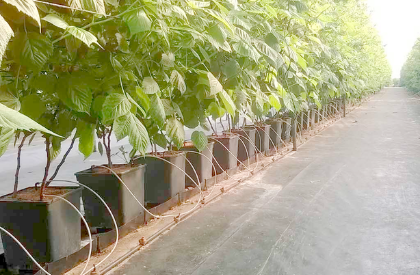Raspberry
Raspberries are categorized mainly into two types. They are primocane (fall-bearing or everbearing types) and floricane (summer bearing). For the hydroponics system, primocane types are recommended, as these produce fruits at the top of first-year canes over a long harvest season. They also need less growing space and support than floricane types. Smaller Raspberry plants do better in containers; some varieties such as Heritage Red, Autumn Bliss, Raspberry Shortcake, and Jewel Black are ideal Raspberries to grow indoors. Jewel Raspberry variety is one of the varieties with fruit that is black rather than the traditional red Raspberry.
- The pH for Hydroponic Raspberries should be 5.8 to 6.5
- The temperature should be kept between 22 and 24°C
- 10-12 hours of light daily optimal but a minimum of 6 hours.
- Optimal humidity range must be 65% -75%
- Harvest about 12 months/year is possible with staggered growth cycles.
Make sure the Raspberries get appropriate lighting. The appropriate lighting will vary based on the Raspberries. Give the Raspberries the appropriate nutrients. Hydroponically grown Raspberry plants have nutrients mixed with water that is put directly over the root system. The exact method varies depending on the growing medium, such as adding nutrients to the water medium or spraying the plant roots with a mixed water-and-nutrient solution for other systems. The nutrient needs vary by plant, so talk to the supplier about the exact amounts necessary for the specific Raspberry plant. Change the solution every 2 weeks for most berries.
Make sure the temperature ranges are appropriate for the specific Raspberries. For example, Raspberries should be kept in temperatures ranging from 22 to 24°C. Grow hydroponic Raspberry plants in deep water culture buckets. Growing Raspberry plants using a hydroponics system gives the grower maximum control of the plant’s nutrition.
CHOOSING AND PREPARING A PLANTING SITE
- Select a sunny, sheltered spot. While blueberries are tolerant of shade, better crops are obtained in the sun. At the same time, they should not be exposed to harsh, drying winds.
- Don’t plant blueberries too close to trees, as the trees will not only block out sunlight, but will also suck up any moisture in the soil.
- If planting multiple bushes, it’s best to plant them in a patch, rather than scattered throughout your garden. This will bolster berry production and quality.
- The blueberry is a shallow-rooted plant. Therefore, it requires a soil that holds moisture, but also drains well and doesn’t stay wet. Don’t plant blueberries in sites that have heavy, clayey soils that stay wet.
- Blueberries thrive in soil that is acidic. The soil pH should ideally be between 4 and 5. Soil can be acidified by mixing a small amount of granulated sulfur into the soil several months before planting. Peat moss, as well as pine bark or needles, are also good additions that will help acidify your soil.
- Mix organic matter into the soil before you set your blueberry bushes. (See more about soil amendments and preparing soil for planting.)
Request Quote
Progressive banana varieties
In local languages, this banana is known as Bhusavali, Basrai, Marisas, Kabuli, Sindurani etc.
It is very popular in India.
Its plant is small, while the fruits are large.
Its pulp appears soft and sweet in food.
This variety is also known as Bambegreen and Harichal.
The areas of the Western Deep Group are famous mainly for its cultivation.
The banana plants can be 3 to 4 meters in height.
While their stem is medium thick and thick green.
Green fruits develop in them.
On an average, each bunch weighs between 25 and 30.
Fruits are yellow.
Customer Feedback
Talented Agronomist
Team Alexa made my Poly-House very well & also helped by assisting in organic Framing. Thanks & All the Best for the future.
Ms. Poonam Saxena, Indore (M.P.)
landownerExcellent job, excellent workmanship
Currently, Team Alexa helping me on Orchid Cultivation in Poly house. I’ve have to say till now everything is good and expecting the same for future.
Mr. Rajendra singh , Indore (M.P.)
landownerGreat ! Work
I would suggest Alexa Farms for Poly house Farming , Hi Tech Farming Organic Farming because there professionals have knowledge for all the crops.
Mahant Dharmendra Puri, Indore
landownerDone Wonderful job
Amazing design and installation of our new, beautiful yard. Gardener is professional, creative and knowledgeable designer.
Mark Angelino
NewyorkPlanting & Removal Charges
Within a your budget you can freshen up your plant with a few key upgrades that will increase your home’s curb appeal. A new gravel driveway or concrete walkway can make your home look like new. Small budgets are good for breaking up a larger project into manageable chunks, so you might splurge for a nice walkway this year and deal with the driveway later.



